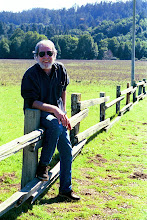In model railroading, where the standards might seem to be different — in some ways less demanding (it's supposed to be fun, and so on; no one's standing over you with a whip, as I sometimes feel, regarding poetry, that the ghost of Keats or T.S. Eliot is standing over me) and yet in others more so — the decisions about what to make public and what to keep to oneself can become difficult — particularly for the so-called "perfectionist."
For instance: I've talked already about posting a track-plan of my layout. I know this would be a boon to any follower(s) of my blog if only in the sense that when they see certain photographed scenes they'll know where they are in that "world", etc. I'm aware myself that while I very much enjoy close-ups and limited perspective photos of other modelers' work, I also am always curious about the bigger picture. A track plan is nearly always provided, for instance, in featured articles on individuals' work in magazines such as Model Railroader. But, interestingly enough, often there are no "bigger picture" shots: it's as if either the editors of MR or the owner/builders of the railroads don't want the spell of the "fictive dream" to be broken or interrupted. Writers know that anything they do which causes a reader to step back, even for a moment, and move outside the story or poem, spells a kind of doom or at the very least indicates that something's wrong with the writing. (On the other hand, were a reader to step away from his or her reading because they might have been distracted by something that moved them deeply in some or another way, or because they wanted to see how a writer had affected some particular move, some particular sleight-of-hand . . . any writer would no doubt be flattered by that.)
While I don't have these same sorts of fears regarding my modeling efforts, I'm still concerned to some degree about presenting my work in the best possible light. Thus though last week or the week before I did, indeed, draw a track-plan, it's hopelessly amateur and pitiful. One might say, "Well, who cares? Let's see that baby . . ." and so on. Frankly, I care, and this is my blog, and so such business is simply going to have to be put on hold till I can find a way to render a track-plan diagram in a way that pleases me. And readers of the blog are going to have to wait a while before they can see the bigger picture. (Might I add, though, that one needn't hold ones breath. Notwithstanding with whatever efficiency I might eventually manage to do this, my railroad is small and seeing a wonderfully rendered diagram of it I guarantee will change no ones life.)
In the meantime, the photos below are various shots of the blast furnace area, which is on a slightly raised level from the rest of the pike. Originally this hadn't been the case, but once I had decided to "build out" enough that I could have at least one continuous run of track, I ran into space and design problems. I solved this by elevating the whole mill area itself, an area about two feet wide by about seven feet long. I used a "view block" to isolate two areas in this part of the layout (more later about this) and, for the most part, have been pleased by how it has worked out — both design- and operation-wise. An "observer" confronting what I've done can fill in the blanks. Modelers count on this: suggest enough or represent enough accurately and the person looking will fill in the rest. (Writers count on this as well, of course — particularly poets. I and my poet friend Melanie Reitzel have long gotten a tremendous kick out of a bit of comedy by Eddie Izzard where he talks about Dr. Heimlich and his invention of the eponymous maneuver that has saved many lives over the years. Izzard "acts out" Dr. Heimlich's early [humorously failed] struggles to perfect his maneuver, and at one point has him saying, "Well, it's not really a maneuver yet . . . it's more of a gesture." A lot of modeling is more or less a gesture, too — and so much of it never perfected nor even approaching that point. But we learn by doing, and by doing we learn.)
Some photos then, here, of the upper mill area — blast furnace and cast house.
(Note: the background on the view block is or was an experiment for me in painting a backdrop. I am no more a painter than I am a draftsman. One can purchase backdrops or background scenes and they're not very expensive, but in keeping with my need to teach myself things and learn from the experiences I decided to ask a cousin of mine, Judy Johnston, an artist and high school art teacher in North Carolina, to help me do "clouds" with acrylics. She did the best she could from a distance and I did the best I could in following her guidance. Oddly enough, I found working with acrylics fascinating, and a new adventure. The results of these first attempts I'm not so sure about, but the view block is removable and I can redo and work with a little more diligence in the meantime on the this background "sky.")








No comments:
Post a Comment